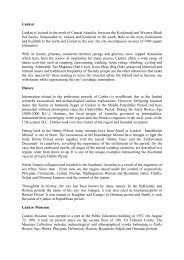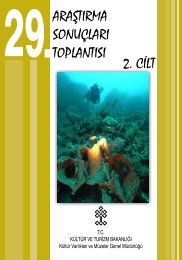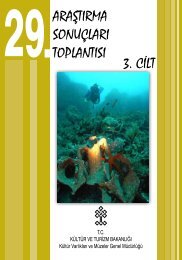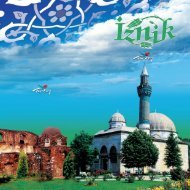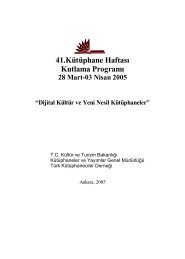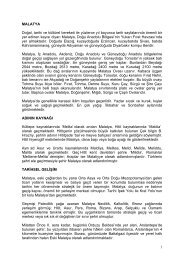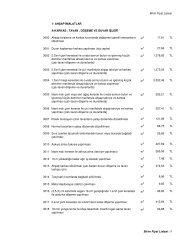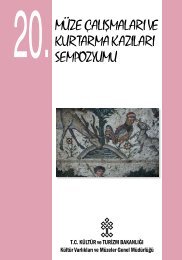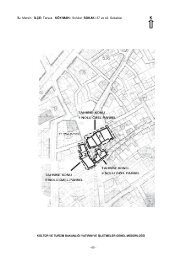MIMAR SINAN IZINDE IST ingilizce kapak.indd - Kültür ve Turizm ...
MIMAR SINAN IZINDE IST ingilizce kapak.indd - Kültür ve Turizm ...
MIMAR SINAN IZINDE IST ingilizce kapak.indd - Kültür ve Turizm ...
Create successful ePaper yourself
Turn your PDF publications into a flip-book with our unique Google optimized e-Paper software.
T.C. <strong>Kültür</strong> <strong>ve</strong> <strong>Turizm</strong> Bakanlığı<br />
Tanıtma Genel Müdürlüğü©<br />
www.kulturturizm.gov.tr<br />
Tour of İstanbul<br />
In The Footsteps Of<br />
MİMAR SİNAN
MİMAR SİNAN &<br />
İSTANBUL1
2<br />
Mimar Sinan (Sinan the Architect),<br />
the 16th-century master architect and<br />
chief administrator of public works<br />
under three Sultans, is the designer<br />
of important masterpieces of superb<br />
Ottoman architecture. His works ha<strong>ve</strong><br />
highlighted the magnicence of the most<br />
signicant period of the Ottoman mpire.<br />
He is therefore the rst name that springs<br />
to mind when considering Ottoman<br />
architecture. Calling him an architect<br />
is not enough though – he was a<br />
genius and the creator of works<br />
that were considered impossible<br />
to achie<strong>ve</strong> by mere mortals. He<br />
was a superb artist since each of his<br />
works reects his continual pursuit for<br />
aesthetics and elegance. His work rate<br />
was unprecedented with his buildings<br />
encompassing the whole of the vast domain of the Ottoman<br />
mpire. His scientic pursuit of eploring beyond the limits<br />
of engineering reects his intellectual capacity. n a sense<br />
he was the euivalent of an intellectual from the uropean<br />
Renaissance. Describing him by his profession “mimar”<br />
(architect) is inadequate, e<strong>ve</strong>n during those times and so he<br />
was referred to as the “” (architect of all<br />
architects).<br />
Sinan embodied architecture. n his memoirs, when<br />
epressing his soul, he used the metaphor of a set of<br />
compasses, which is one of the essential architectural tools,<br />
and thereby giving us a real insight into his personality. He<br />
was as steady as the pivot arm of the compasses, always<br />
trying until he achie<strong>ve</strong>d the best, and he was as mobile<br />
as the drawing arm of the compasses, always pursuing<br />
new horizons and new ideas by tra<strong>ve</strong>lling to new places<br />
and visiting other masterpieces. Using this symbolism he<br />
designed his nal resting place, his tomb, which seems <strong>ve</strong>ry<br />
plain when compared to all the masterpieces he created, in<br />
the form of set of compasses.<br />
Mimar Sinan described the Selimiye Mosque in dirne<br />
as his main work during his period of mastery. Howe<strong>ve</strong>r,<br />
because of his humble approach, o<strong>ve</strong>rlooking the works he<br />
previously accomplished would be a great irre<strong>ve</strong>rence to<br />
his genius. <strong>ve</strong>n if he did not acknowledge all of his works<br />
are the outcome of his superb mastery and unique talent.<br />
Other magnicent old architectural masterpieces pale into<br />
insignicance when compared with the works of<br />
Mimar Sinan. With his works he constantly<br />
amazed all those who had been mesmerized<br />
by the masterpieces of earlier architects and<br />
who thought that such mastery could not be<br />
surpassed. All those years ago, he de<strong>ve</strong>loped<br />
<strong>ve</strong>ry advanced ideas for buildings that could<br />
resist powerful earthquakes, something which<br />
is still a major consideration for present day<br />
architecture. He preferred to use long-lasting<br />
materials in his buildings such as re stone (a<br />
greenish coloured volcanic tuff quarried near the<br />
Sea of Marmara and renowned for its strength and<br />
re resistance), and de<strong>ve</strong>loped an earthquake-resistant<br />
foundation system. He paid great attention to the acoustics
4<br />
in the buildings he created and also de<strong>ve</strong>loped quite<br />
intricate <strong>ve</strong>ntilation systems, parts of which ha<strong>ve</strong> remained<br />
uneplained to the present day.<br />
Although Mimar Sinan completed more than three hundred<br />
works during his lifetime, the buildings that he is most well<br />
known for are mosques. His legacy was carried to the far<br />
corners of the earth by his apprentices such as Davud Agha<br />
and Sedefkar Mehmet Agha. The Sultan Ahmet Mosque<br />
in stanbul, which has become a symbol of the city, and the<br />
Taj Mahal in Agra, ndia, were designed and built by those<br />
who were trained by Mimar Sinan and took their re<strong>ve</strong>red<br />
place in the history of the world’s architecture.<br />
And stanbul<strong>ve</strong>ry view is t for a picture postcard,<br />
and the city is like an open air museum where its famous<br />
silhouette has been greatly enhanced by the buildings<br />
created by Mimar Sinan. Sinan’s signature in this unique<br />
city is the buildings standing among the imposing hills. For<br />
him, stanbul was the city where he fullled his architectural<br />
dreams and designs and wrote his name in golden letters in<br />
the history of architecture. During the military campaigns<br />
he took part in as well as the journeys he made around the<br />
world, he was inspired by the buildings he had seen and<br />
he used his eperiences and observations in the buildings<br />
he designed and built in stanbul. Therefore calling<br />
stanbul the City of Mimar Sinan’ is not an eaggeration.<br />
Not only did he design the main capital buildings but<br />
he also played an important role in the urban design of<br />
stanbul. As a master of urban design, with great insight,<br />
he demolished buildings which did not t in with o<strong>ve</strong>rall<br />
look of stanbul and built wide thoroughfares. He always<br />
paid great attention to the harmony of his buildings with<br />
the topography of their sites. When a work was appro<strong>ve</strong>d,<br />
he rst visited and in<strong>ve</strong>stigated suitable sites he then drew<br />
the plans and designed a suitable foundation system as well.<br />
Studying the sites of his masterpieces gi<strong>ve</strong>s an insight into<br />
Sinan’s talent in urban design.<br />
As you will appreciate, a trip to stanbul to see the principal<br />
works of Mimar Sinan cannot be completed in one day.<br />
Therefore you should take se<strong>ve</strong>ral days eploring different<br />
routes through the historic streets with the breathtaking<br />
scenery of the stanbul Strait. ou may choose to take one<br />
of the routes where you can view the buildings on the same<br />
itinerary during a day trip. f you wish you might e<strong>ve</strong>n<br />
attempt to follow more than one route in a day but this<br />
may be a bit tiring. Howe<strong>ve</strong>r, remember that because of<br />
the beauty of Mimar Sinan’s works you need to spend quite<br />
some time visiting them in order to fully appreciate.
6<br />
BEFORE STARTING THE TOUR<br />
- Some of the buildings by Mimar Sinan in stanbul are<br />
quite easy to nd due to their prominent location. Howe<strong>ve</strong>r,<br />
some are hidden among modern buildings and are quite dif-<br />
cult to nd. Therefore, obtaining the professional services of<br />
a guide for these buildings can be useful.<br />
- The routes ha<strong>ve</strong> been formed according to the proimity<br />
of the works of Mimar Sinan to each other. These buildings<br />
are also located in the same region with other Byzantine and<br />
Ottoman buildings of worldwide importance. Therefore, if<br />
you also wish to visit these buildings you should split your tour<br />
routes o<strong>ve</strong>r a couple of days at least.<br />
- Some buildings by Sinan, especially some of the tombs,<br />
are only open to visitors by prior arrangement or on certain<br />
days. n order to visit the buildings owned by private companies<br />
you should obtain the owners’ permission. Visiting the<br />
buildings under restoration is also subject to permission.<br />
- Most of Sinan’s mosques are open for worship. Therefore,<br />
during certain hours of the day you may not be able to obtain<br />
access or take photographs, or there may be restrictions on<br />
these activities.
Eminönü<br />
7
8<br />
<br />
<br />
- Pay particular attention to the topography of the plot<br />
and the positioning of the buildings on the plots. One of<br />
the dening features of Sinan’s genius in urban planning<br />
was his mastery in achieving harmony of the architecture<br />
with nature through selecting the sites and positioning his<br />
designs on those sites. Also pay attention to the entirety of<br />
his designs especially in his complees where each building<br />
is in harmony with the natural topography.<br />
- Pay attention to the pillars supporting the domes. ach<br />
of them was kept as slender as possible, while safely and<br />
securely bearing the weight of the dome, and through<br />
this mastery of civil engineering he achie<strong>ve</strong>d capacious<br />
interiors.<br />
- Mimar Sinan paid keen attention to the skeleton system<br />
in his buildings and his prime concerns of symmetry and<br />
aesthetics are <strong>ve</strong>ry characteristic. When visiting, check these<br />
trademark features of symmetry and aesthetics that can be<br />
obser<strong>ve</strong>d e<strong>ve</strong>n in his simplest buildings.<br />
- Mimar Sinan was instrumental in de<strong>ve</strong>loping the central<br />
dome and in all his buildings all other structural features<br />
ha<strong>ve</strong> a role to play in supporting the central dome. The<br />
dome is the jewel in the crown in Sinan’s masterpieces.<br />
n particular, pay attention to the central dome and its<br />
relationship to other structural features in the Süleymaniye<br />
Mosque, since it still enchants modern-day engineers and<br />
architects. The technique he used to provide spatial entirety<br />
by en<strong>ve</strong>loping the whole interior space under a central<br />
dome is outstanding.<br />
- One of the features special to the Mimar Sinan’s<br />
designs, especially in the mosques dedicated to some of the<br />
Grand Viziers and the Grand Admirals, was providing the<br />
space for late congregants, as well as common courtyards<br />
surrounded by madrasah and mosque structures.<br />
- The massi<strong>ve</strong> piles made from juniper timber were used<br />
in the foundations of buildings such as the Süleymaniye<br />
Mosque in order to absorb the impact of earth tremors as<br />
well as to provide ample opportunities for draining surface<br />
and sub-surface water.<br />
- n Mimar Sinan’s buildings each and e<strong>ve</strong>ry architectural<br />
feature has a function. ou realise that none of them can<br />
be remo<strong>ve</strong>d without damaging a function or architectural<br />
entity belonging to the building.<br />
- Mimar Sinan ne<strong>ve</strong>r repeated himself in his building<br />
designs, always trying new variations and impro<strong>ve</strong>ments. f<br />
you casually look at them you may think some of his buildings<br />
look alike. Howe<strong>ve</strong>r, a closer and more careful inspection<br />
will lead you to realise the differences and impro<strong>ve</strong>ments<br />
achie<strong>ve</strong>d e<strong>ve</strong>n in the similar looking buildings.
9<br />
Sokollu Mehmet Pasha Mosque
1. Üsküdar -<br />
Sultanahmet<br />
Tours<br />
<br />
<br />
<br />
<br />
<br />
<br />
<br />
<br />
<br />
<br />
<br />
<br />
<br />
<br />
<br />
11
Nurbanu Valide Atik Complex<br />
12<br />
<br />
The Mimar Sinan ecursion in sküdar is one of the<br />
shortest tours so it is possible to combine this with the<br />
Sultanahmet tour.<br />
f you arri<strong>ve</strong> in sküdar by boat, you will not fail to notice<br />
the works of Mimar Sinan since they were built <strong>ve</strong>ry close to<br />
the pier, and all are within walking distance. Howe<strong>ve</strong>r, if you<br />
choose to combine your ecursion in sküdar with the tour<br />
of Sultanahmet, you should start by visiting the <br />
(built between the years 1570 and<br />
1583) , which was built on one of the hills of sküdar<br />
and is a little further to visit than the other Sinan buildings<br />
in sküdar. As the hill is quite steep, we advise you to use<br />
public transport. The comple encompassing the mosque<br />
is one of the most etensi<strong>ve</strong> and grandest complees in<br />
stanbul. t was the Valide Sultan (Mother Sultan) Comple<br />
until the Mother Sultan Gülnu commissioned the New<br />
Mother Sultan Comple in sküdar at the beginning of<br />
the 18th century. Since then it has been referred as the “Old<br />
Mother Sultan” and then “Atik Mother Sultan” Comple.<br />
To make use of the sloping terrain, the comple is sited on<br />
se<strong>ve</strong>ral terraced platforms. The grand design of the whole<br />
comple was made by Mimar Sinan and it comprised a<br />
madrasah (school of religious studies) a tekke (ceremonial<br />
building of worship) a sübyan mektebi (primary school),
a dar-ül hadis (Hadith School), a dar-ül kurra (school for<br />
learning the Quran), imaret (public kitchens), a <br />
(hospital) and a hammam (public bathhouse). n modern<br />
times the buildings of the comple ha<strong>ve</strong> become separated<br />
by streets.<br />
The central building of the comple is the mosque with<br />
its marble car<strong>ve</strong>d minber (the imam’s pulpit for deli<strong>ve</strong>ring<br />
sermons in the mosque) and mihrab (the niche in the wall<br />
indicating the qibla, the direction of Kaaba in Mecca)<br />
decorated with hand-painted tiles the hand-painted<br />
decoration of the dome and the mother-of-pearl inlaid<br />
gates are also equisite eamples to enjoy. The dar-ül kurra<br />
stands before you when you lea<strong>ve</strong> the mosque. Although<br />
it is not allowed to visit this building, a glance from the<br />
outside still re<strong>ve</strong>als its features. Across from the northern<br />
entrance of the mosque is the area which is used as the<br />
Centre of Decorati<strong>ve</strong> Arts. t was once the khankah, the<br />
buildings for the dervish lodge containing the cells of the<br />
dervishes. Today it is used for the production and ehibition<br />
of traditional decorati<strong>ve</strong> arts and also for giving education<br />
in this eld. t is also used for cultural e<strong>ve</strong>nts and there is a<br />
gift shop where you can buy items of traditional arts such<br />
as hat (calligraphy), tezhip (gilding and illuminating), and<br />
ebru (marbling).<br />
13
14 Mihrimah Sultan Mosque
To the west of these buildings, on a lower le<strong>ve</strong>l, are the<br />
darüifa and public kitchens. They ha<strong>ve</strong> been used for<br />
many different purposes throughout their history, including<br />
being used as a prison therefore they ha<strong>ve</strong> lost their original<br />
characters. As the buildings are now part of the Uni<strong>ve</strong>rsity<br />
of Marmara, you need to ask for permission to visit and to<br />
take photographs.<br />
From these buildings you can take a short walk down the<br />
slope to Quay Square to visit se<strong>ve</strong>ral more of the buildings<br />
of Mimar Sinan which are close to one another. The rst<br />
to visit is the (built between<br />
the years 1547 and 1548). t is also known as the Quay<br />
Mosque since it is <strong>ve</strong>ry close to the quayside. Mihrimah<br />
Sultan was the belo<strong>ve</strong>d daughter of Sultan Süleyman the<br />
Magnicent. This mosque is one of the earliest eamples of<br />
the creati<strong>ve</strong> genius of Mimar Sinan. He had already built<br />
ehzade (Prince) Mosque, where he built the main dome<br />
being supported by four half-domes. Howe<strong>ve</strong>r, in the design<br />
of this mosque he built the main dome being supported by<br />
three semi-domes. He used this plan only in this building.<br />
The faade facing the stanbul Strait is another feature<br />
adding to the splendour of the building. The ablution<br />
fountain of the mosque was set in the centre of the front<br />
courtyard and it was merged structurally with the portico<br />
for the late congregants. The ablution fountain is one of<br />
the most beautiful eamples in stanbul. The minber of the<br />
mosque with its intricate marquetry is also worth a closer<br />
look.<br />
f you walk in a southerly direction from this building you<br />
will shortly reach another work of Mimar Sinan. <br />
(double hammam), which is known as the<br />
today was commissioned by<br />
Nurbanu Sultan, the mother of Sultan Murat . t was<br />
the last public bathhouse built by Mimar Sinan. For many<br />
years it ser<strong>ve</strong>d as the public bathhouse in the sküdar<br />
marketplace, and since its closure the rooms in its interior<br />
ha<strong>ve</strong> been con<strong>ve</strong>rted to ser<strong>ve</strong> as shops.<br />
Mimar Sinan Bazaar<br />
15
16<br />
The mosques of Mimar Sinan in sküdar are the only<br />
buildings that he positioned so close to the sea. The best<br />
eample of this is the ,<br />
which is on the southern part of the quay. The mosque is so<br />
close to the sea that wa<strong>ve</strong>s literally break o<strong>ve</strong>r the walls and<br />
it is the only one where this happens. t is also one of the<br />
best eamples of the buildings which are in harmony with<br />
nature. The small sizes of the mosque and the madrasah<br />
are the results of Mimar Sinan’s architectural ingenuity.<br />
Although the lay of the terrain allowed only for a small<br />
plot, the building was masterfully built along the shore.<br />
n each of Sinan’s designs the positioning of the building<br />
within its plot has been his greatest strength. n this mosque<br />
the foundations were laid o<strong>ve</strong>r the sea so that the seascape<br />
merged with the façade of the mosque.<br />
From the vantage point of the courtyard of the mosque<br />
there is a magnicent view o<strong>ve</strong>r the Strait and the historic<br />
peninsula, which mere words cannot describe – especially<br />
during sunset. So, when you ha<strong>ve</strong> nished your ecursion<br />
we recommend that you spare a moment to enjoy this view.<br />
ou can tra<strong>ve</strong>l from sküdar to minnü by boat. f<br />
you sit in the open air section of the boat, you can also<br />
enjoy the memorable views during the ride. Kz Kulesi<br />
(Leander’s Tower), built on a rocky outcrop in the middle<br />
of the stanbul Strait, lends itself to the picturesque scene<br />
of stanbul. The beautiful historic houses set on the ridge of<br />
Salacak for a moment make you forget that you are in the<br />
footsteps of Mimar Sinan.
17
18<br />
<br />
Sultanahmet is one of the prime locations in stanbul for<br />
visitors. As the centre of the Byzantine mpire, the historic<br />
peninsula is full of buildings to visit that span two millennia.<br />
n this historic peninsula which hosted many momentous<br />
e<strong>ve</strong>nts and glorious festivities in the past, you can see the<br />
most prominent eamples of Sinan’s buildings and of works<br />
that ha<strong>ve</strong> taken important place in the history of world<br />
architecture.<br />
The rst stop on the tour of Sultanahmet is the <br />
. The palace was used by the Ottoman Sultans<br />
as their seat of power as well as their residence and e<strong>ve</strong>ry<br />
corner is full of surprises and hidden splendours. The<br />
building by Mimar Sinan contributing to the splendour of<br />
Topkap is the , which<br />
is the only palace construction that the great architect<br />
undertook. The harem quarters at Topkap Palace are a<br />
group of buildings that were continually added to by the<br />
Sultans. When Sultan Murat decided to build a chamber<br />
for himself, his preference was to commission Mimar<br />
Sinan. The chamber, decorated with the best znik tiles,<br />
is of historic importance, with Sinan’s nesse in creating<br />
grandiose buildings being <strong>ve</strong>ry strikingly translated into<br />
this small, private construction. The same mastery can be<br />
seen in the with<br />
their impressi<strong>ve</strong> chimneys reecting<br />
the trend for high smokestacks.<br />
Mimar Sinan o<strong>ve</strong>rsaw the repair<br />
of the kitchen section of the<br />
palace during the 15 th century and<br />
replanned the buildings according<br />
to the needs of the day.
19
20
When you ha<strong>ve</strong> nished your tour of the<br />
Topkap Palace you may prefer to visit other<br />
buildings, so we recommend that you choose<br />
to walk from one building to another in<br />
order to fully enjoy the riches of this historic<br />
peninsula. ou will nd that Sinan’s buildings<br />
are all <strong>ve</strong>ry close by.<br />
The rst stop before reaching the monumental<br />
is the <br />
(1559) situated on the<br />
Caferiye Street. The original features of the<br />
building ha<strong>ve</strong> largely remained to the present<br />
day and it is currently used as a centre for<br />
handicrafts. So when you visit this building<br />
you will ha<strong>ve</strong> the chance to watch the making<br />
of traditional Turkish handicrafts, look at the<br />
works of art on display, or enjoy refreshments<br />
at the cosy courtyard café.<br />
Mimar Sinan’s contribution to stanbul was<br />
not limited to his designs and buildings.<br />
He also carried out important repair and<br />
renovation works that resulted in many older<br />
masterpieces still standing today. Our net<br />
stop is one of<br />
them and it is among the most important<br />
symbols of stanbul. The most important<br />
renovation work that Sinan completed here<br />
invol<strong>ve</strong>d the dome and he also added massi<strong>ve</strong><br />
buttresses to support the walls and two<br />
minarets to the northern façade. His efforts<br />
to ensure that the minarets were in harmony<br />
with the rest of the building not only reect<br />
his respect for the grand old building but also<br />
his mastery. n order to achie<strong>ve</strong> this harmony<br />
he reinterpreted the classical ratios and<br />
details of a minaret.<br />
21
22<br />
Sokollu Mehmet Pasha Mosque<br />
The (1577), a monumental<br />
building constructed in the courtyard of Ayasofya, is also<br />
a work of Mimar Sinan. The Ottoman Sultans preferred<br />
to be buried in the courtyards of the mosques built for<br />
their own glory. Howe<strong>ve</strong>r, Sultan Selim built his royal<br />
mosque in dirne, and as he had commissioned major<br />
work at Ayasofya he chose its courtyard as the site for his<br />
tomb. There are forty-two sarcophagi including the one of<br />
Nurbanu Sultan, the wife of Sultan Selim .<br />
Walking from Ayasofya Museum to the Sultan Ahmet<br />
Mosque you can visit the <br />
(1556-1557) which stands between these two glorious<br />
buildings. t is one of the monumental double hammams<br />
of stanbul that has maintained its unique features. t<br />
was devoted to Hürrem Sultan, the wife of Süleyman the<br />
Magnicent, and was built by Mimar Sinan.<br />
When you lea<strong>ve</strong> the hammam, walk along the Atmeydan<br />
(the ancient Hippodrome). The Sultan Ahmet Mosque<br />
(the Blue Mosque) on your left was not built by Mimar<br />
Sinan but one of his apprentices, Sedefkar Mehmet Agha.<br />
Considering the fact that yet another apprentice of Mimar<br />
Sinan, Mehmet sa ffendi, built the Taj Mahal in ndia,<br />
you can appreciate how inuential he was in shaping the<br />
world architecture and how his legacy spread through the<br />
ages.<br />
At the end of the Atmeydan the road slopes down to the<br />
shore. At the Kadrga Sokak you come across the mosque<br />
built by Sinan for the Grand Vizier <br />
. Despite its smaller scale, its interior is one of<br />
the most striking eamples of Mimar Sinan’s work, not only<br />
in stanbul but throughout all of his work. With its worldrenowned<br />
znik tile decorations and panelling, as well as its<br />
intricate mihrab, the mosque is the last stop of the Mimar<br />
Sinan tour in Sultanahmet.
2323
2. KARAKÖY-TOPHANE-<br />
BEŞİKTAŞ - ORTAKÖY<br />
Tours<br />
<br />
<br />
<br />
<br />
<br />
<br />
<br />
<br />
The ttour<br />
starts at the Atatürk Bridge that connects Galata<br />
to the<br />
historic peninsula and proceeds along the shores<br />
of of the th Golden Horn (Haliç) and the stanbul Strait, with<br />
magn magnicent views of the the Strait and the Boaziçi<br />
Bridg Bridge, uniting two continents.
28<br />
Sokollu Mehmet Pasha Mosque
The rst building by Mimar Sinan that we come across is<br />
the (also known as the<br />
due to the name of the district) .<br />
Mimar Sinan built se<strong>ve</strong>ral complees in various parts of<br />
stanbul for this famous Grand Vizier of the period. The<br />
mosque was originally built as part of a comple. Howe<strong>ve</strong>r,<br />
the other buildings in the comple ha<strong>ve</strong> long gone, so<br />
today the mosque stands on its own. The interior layout<br />
is <strong>ve</strong>ry similar to the Selimiye Mosque, albeit on a smaller<br />
scale. One of the interesting aspects of the mosque is the<br />
location of its minaret, which is separate from the building<br />
and is connected to the portico via a bridge. The car<strong>ve</strong>d<br />
grilles of the portal and windows as well as two staircases<br />
leading to the enclosed portico reect the ne quality of<br />
the marble carving minber which is also one of the must<br />
see parts of the mosque. The detached minaret is a feature<br />
that Mimar Sinan ne<strong>ve</strong>r used again. The Sokollu Mehmet<br />
Pasha Hammam is situated opposite the mosque alas, the<br />
features from Mimar Sinan’s period ha<strong>ve</strong> been lost.<br />
29
30<br />
The buildings by Mimar Sinan that are visited on this tour<br />
are quite close to the shore so they are easy to nd. The<br />
eception is the (1544)<br />
, also known as Kurunlu Han, situated in the middle<br />
of Thursday Market and surrounded by se<strong>ve</strong>ral shops and<br />
therefore quite difcult to nd. The rooms are presently<br />
used as shops and for storage.<br />
f we proceed along the route enjoying the beauty of the<br />
stanbul Strait, we pass the Karaky Boat Pier and on the<br />
Meclisi Mebusan Street we reach the neighbourhood of<br />
Tophane.
There you are greeted by the grand architecture of the<br />
(1580-1587)<br />
. This monumental building was built for one of the<br />
Grand Admirals of the Ottoman Armada and is the rst<br />
of se<strong>ve</strong>ral buildings on the route devoted to the Grand<br />
Admirals. The comple was commissioned by Klç Ali<br />
Pasha. Howe<strong>ve</strong>r, only the mosque and the public bathhouse<br />
ha<strong>ve</strong> survi<strong>ve</strong>d. The Tomb of Klç Ali Pasha was positioned<br />
at the seaward corner of the mosque so that he could nd<br />
eternal rest in the sound of wa<strong>ve</strong>s and the smell of the sea<br />
that had accompanied him during his years at sea. The plan<br />
of the mosque is quite similar to that of Ayasofya Museum.<br />
A two-part space for late congregants is a feature we come<br />
across in Sinan’s buildings devoted to the Grand Admirals.<br />
A horseshoe-shaped gallery surrounds the interior. The<br />
public bathhouse with its star-shaped layout was added to<br />
the comple to ser<strong>ve</strong> the sailors of the Ottoman Armada.<br />
<br />
31
32<br />
Frequent res in stanbul ha<strong>ve</strong> caused etensi<strong>ve</strong> damage to<br />
some of Sinan’s buildings. <br />
, that has suffered si res, is one of the unluckiest.<br />
The mosque has lost almost all of its architectural features<br />
from Sinan’s period. Howe<strong>ve</strong>r, it is worth a quick visit as it<br />
is situated on Cihangir okuu Street, which is on the route<br />
of the tour. While the building has lost much of its charm,<br />
the courtyard has the best views o<strong>ve</strong>r the stanbul Strait,<br />
including from Ayasofya and Sultanahmet to the Prince<br />
slands and Leander’s Tower.<br />
The net Sinan building on the route<br />
is the <br />
(1586) . Compared<br />
to other monumental buildings by<br />
Mimar Sinan, this mosque is quite<br />
small but is fascinating ne<strong>ve</strong>rtheless<br />
since it was built alongside the<br />
stanbul Strait. t is one of the<br />
heagonally shaped mosques designed by<br />
Mimar Sinan and was commissioned by<br />
the (the judge) of stanbul, Mehmet<br />
Vusuli ffendi.
33
34
The net Sinan building on the route does require some<br />
walking. Howe<strong>ve</strong>r, the views are eceptional. The route<br />
passes by the Dolmabahçe Palace situated along the shore of<br />
the stanbul Strait and reaches two of the Sinan’s buildings<br />
situated close by in Beikta district. These buildings<br />
commemorate two famous names from the Ottoman navy.<br />
The rst of these buildings is the <br />
(1541) , situated near the Naval<br />
Museum. Mimar Sinan built the nal resting places for<br />
many important personages from the Ottoman mpire.<br />
The Tomb of Barbaros Hayrettin Pasha is one the best<br />
eamples. The rst Grand Admiral of the Ottoman navy,<br />
Barbaros Hayrettin Pasha, was renowned for his victory at<br />
the Battle of Pre<strong>ve</strong>za. A betting tomb for such a renowned<br />
mariner should indeed be placed right net to the sea with<br />
the e<strong>ve</strong>rlasting sound of wa<strong>ve</strong>s and a magnicent seascape.<br />
The tradition was that the grand eet leaving from the port<br />
of stanbul for a campaign would salute as they passed the<br />
tomb. The inside of the tomb is open to visitors only two<br />
days a year, 4 th April and 1 st July.<br />
35
36<br />
Grand Admiral Sinan Pasha was another important person<br />
from the Ottoman navy. The mosque bearing his name was<br />
also built by Mimar Sinan. This <br />
(1555-1556) is opposite the Tomb of Barbaros<br />
Hayrettin Pasha. The Grand Fleet of the Ottoman navy<br />
traditionally performed a prayer (namaz) at the mosque<br />
after saluting the Tomb of Barbaros Hayrettin Pasha<br />
before setting sail for a campaign. Mimar Sinan’s design<br />
incorporated the plan of the ç erefeli Mosque (The<br />
Mosque with Three Minaret Balconies) in dirne. The<br />
arabesque painted ceilings and walls of the interior and<br />
the twin spaces for late congregants are the distinguishing<br />
features. The madrasah which shares its courtyard with the<br />
mosque was also built by Mimar Sinan.
37
38
ou then proceed from Beikta along the raan Street, a<br />
tree-lined boulevard leading to the ldz Park situated on<br />
the left hand side of the road. The narrow street leading<br />
up the hill is ahya ffendi Street and here you can nd<br />
the also built by Mimar<br />
Sinan. ahya ffendi’s mother was a wet-nurse for Sultan<br />
Süleyman the Magnicent. His tomb which is situated in<br />
the centre of a gra<strong>ve</strong>yard is frequently visited by mariners<br />
since he is belie<strong>ve</strong>d to be the guardian of the Strait. As it has<br />
been repaired se<strong>ve</strong>ral times o<strong>ve</strong>r its history it has lost many<br />
of its architectural features from Sinan’s period. Howe<strong>ve</strong>r,<br />
it is worth a visit to listen to the stories about the miracles<br />
of ahya ffendi. As reaching the gra<strong>ve</strong>yard requires<br />
quite a climb it is one of the least accessible of all the sites.<br />
Howe<strong>ve</strong>r, its unique hilltop position with its view o<strong>ve</strong>r the<br />
stanbul Strait is worth the effort. f you ha<strong>ve</strong> limited time,<br />
you could perhaps postpone this visit together with the<br />
further eploration of ldz Park, one of the large green<br />
parks in stanbul.<br />
From here you can either tra<strong>ve</strong>l by car or walk along the<br />
Muallim Naci Street, lying alongside the stanbul Strait,<br />
to reach the Ortaky Neighbourhood. At the junction of<br />
Dereboyu and Muallim Naci streets you nd the <br />
. As it has been con<strong>ve</strong>rted to<br />
ser<strong>ve</strong> as a bar during the e<strong>ve</strong>nings it is closed to visitors<br />
during the day and gaining access is only possible by prior<br />
arrangement. Howe<strong>ve</strong>r, you can refresh yourself at this<br />
place commemorating Mimar Sinan. ou can also choose<br />
to enjoy a drink or a snack at one of the cafés around<br />
Ortaky Mosque, adorned with the beautiful scenery and<br />
views o<strong>ve</strong>r the Boaziçi Bridge at sunset.<br />
39
42<br />
3. Fatİh -<br />
Eyüp Tours
Mehmet Pasha Mosque<br />
<br />
We start our tour in Fatih in the aramba Neighbourhood.<br />
As the street layout is quite comple and Mimar Sinan’s<br />
buildings are often hidden by modern buildings, you may<br />
need the assistance of an epert guide. First stop is the<br />
(1584-1587) .<br />
was the Chief Clerk at the Ottoman Court, whose<br />
primary function was to inscribe the imperial monogram<br />
() of the Sultan on the imperial documents. t is<br />
belie<strong>ve</strong>d that the design and construction were commenced<br />
under Mimar Sinan. Howe<strong>ve</strong>r, it was completed by his<br />
apprentices. The of Sultan Murat , which was<br />
designed by Nianc Mehmet Pasha, can be seen on the<br />
main portal of the mosque. The Tomb of Nianc Mehmet<br />
Paa is in the courtyard adjacent to the mosque. The minber<br />
of the mosque is a <strong>ve</strong>ry good eample of stone carving.<br />
(1585) , also<br />
known as , is situated at the<br />
junction of Akemsettin and Fevzipasha streets. The most<br />
striking feature of the mosque is that the place normally<br />
occupied by , the ablution fountain, is taken up<br />
by the tomb, which is <strong>ve</strong>ry rare in Ottoman architecture.<br />
Mesih Mehmet Pasha, who was the Grand Vizier of Sultan<br />
Murat , commissioned the mosque in 1585, died in 1592<br />
and was buried in the tomb. As the plot of land on which<br />
the mosque was built was steeply inclined, the mosque was<br />
built o<strong>ve</strong>r a raised platform and to the ground oor of the<br />
west façade a range of shops was placed. The construction<br />
of this mosque was again belie<strong>ve</strong>d to be started by Mimar<br />
Sinan and completed by his apprentices.<br />
Mesih Ali Pasha Mosque<br />
45
46<br />
Near the Stadium of Karagümrük stood the <br />
(1558) , currently the<br />
Fatih Policlinic, and the net stop on our tour of Mimar<br />
Sinan’s works. Generally, madrasahs were built as part of<br />
a comple. Howe<strong>ve</strong>r, this one was designed and built as<br />
a single independent entity. Due to re and earthquake<br />
damage it has lost most of its unique characteristics created<br />
by Mimar Sinan.<br />
Semiz Ali Pasha Madrasah
Mihrimah Sultan Mosque<br />
f you walk along the Fevzipaa Street that passes in<br />
front of the madrasah, you will reach the net stop. The<br />
(1562-1565) is situated<br />
net to the city walls at dirnekap. ts impressi<strong>ve</strong> dome<br />
rising to the sky attracts your attention from far away. t<br />
shares a common courtyard with its madrasah and was built<br />
o<strong>ve</strong>r a raised platform. The arches supporting the dome are<br />
full of windows that provide ample light for the interior.<br />
ou must also take a closer look at the marble minber as<br />
well as the window and door frames, which are inlaid with<br />
mother-of-pearl and ivory on wood reecting the glory of<br />
Sinan’s masterpieces. The Tomb of Güzel (Handsome)<br />
Ahmet Pasha, son-in-law of Mihrimah Sultan, situated in<br />
the grounds of the comple, was also designed and built<br />
by Mimar Sinan as was the Mihrimah Sultan Hammam.<br />
Howe<strong>ve</strong>r, the hammam has lost its unique features due to<br />
etensi<strong>ve</strong> repairs.<br />
47
48
After visiting this comple, you cross the city walls and<br />
lea<strong>ve</strong> the city’s historic peninsula to proceed towards<br />
yüp. Although you can walk here we advise you to use<br />
public transport.<br />
yüp, the district of stanbul famous for its tombs and<br />
historical gra<strong>ve</strong>yards, is considered as a holy place.<br />
Here, the buildings by Mimar Sinan follow a general<br />
theme in that they mainly consist of tombs. This holy<br />
part at the mpire’s heart was frequently visited by<br />
the Ottoman Sultans and many signicant personages<br />
who also wished their tombs built here. Mimar Sinan<br />
provided them with buildings designed with elegance<br />
and of eternal beauty. Besides, some of his complees<br />
and mosques in the vicinity of yüp can be easily<br />
visited during this tour.<br />
The (1541)<br />
is the rst stop on our tour of yüp. The <br />
was the title equivalent to Chancellor of the chequer<br />
in the 16 th century, and Mahmut elebi was also an<br />
inuential calligrapher of his time, his skills being<br />
reected on the inscriptions abo<strong>ve</strong> the entrance portal.<br />
The masjid is right across from the Feshane (an old<br />
tetile factory along the shore of the Golden Horn<br />
which is nowadays used as an entertainment centre<br />
during the festivities of Ramadan) and is part of the<br />
comple. The other buildings of the comple ha<strong>ve</strong><br />
long since disappeared although the masjid has been<br />
partially renovated. n e<strong>ve</strong>ry religious building there is<br />
a part symbolising the religion. The symbol of slam<br />
is the crescent moon which is placed o<strong>ve</strong>r the minaret<br />
of the mosques. Howe<strong>ve</strong>r, o<strong>ve</strong>r the minaret of this<br />
mosque, a pen and an inkpot were placed to gi<strong>ve</strong> the<br />
message that literacy is the best way of enlightenment<br />
and modernisation. These pen and inkpot which were<br />
damaged by earthquakes ha<strong>ve</strong> been replaced again<br />
o<strong>ve</strong>r the minaret at an early date.<br />
49
50<br />
f you continue walking west on the same street you will<br />
come to the , which<br />
has high-rise façades so that it is almost impossible to see the<br />
dome from street le<strong>ve</strong>l. The comple has twin madrasahs<br />
and the upper madrasah and the mosque share the same<br />
courtyard. n order to follow the design of the streets the<br />
street façade was built without a portico. The mosque has<br />
one of the most ornamental façades of all of Mimar Sinan’s<br />
buildings built in 1540. Zal Mahmut Pasha and his belo<strong>ve</strong>d<br />
wife, ah Sultan, who were ne<strong>ve</strong>r apart, died within a short<br />
time of one another and their tombs were built close to each<br />
other. While all the other daughters of Sultan Selim were<br />
buried in the family tomb in the courtyard of Ayasofya,<br />
these two lo<strong>ve</strong>rs were buried close by so that they were not<br />
e<strong>ve</strong>n separated by death. So we recommend that you pay a<br />
visit to both tombs just to honour their story. The rooms of<br />
the madrasah are used for handicraft workshops where the<br />
renowned wooden yüp toys are made. The Tomb of ah<br />
Sultan which is outside the boundaries of the mosque ser<strong>ve</strong>s<br />
as the premises for the Association for the Preservation of<br />
Old Buildings.
Zal Mahmut Pasha Complex<br />
51
52
Sokollu Mehmet Pasha, the famous Grand Vizier of the<br />
Ottoman mpire, commissioned se<strong>ve</strong>ral buildings to Mimar<br />
Sinan. His own tomb, the <br />
, is the rst tomb that we visit in yüp built by<br />
Mimar Sinan. t is part of the comple bearing his name<br />
and situated net to the yüp Sultan Mosque which is<br />
considered as the most sacred part of the area. The outward<br />
appearance of the tomb was left <strong>ve</strong>ry plain as request by<br />
Mehmet Pasha in his will. There are also headstones for the<br />
children of Mehmet Pasha in the tomb. Like many other<br />
tombs it is closed to visitors ecept on certain dates. The<br />
other buildings by Sinan which are part of the comple<br />
are the dar-ül kurra commissioned by Mehmet Pasha for<br />
his wife, smihan Sultan, and the madrasah, currently a<br />
policlinic.<br />
After the Sokollu Mehmet Pasha Comple, the net stop is<br />
the , just across the street.<br />
Although he commissioned the tomb for his children, he<br />
too was buried there. While Mimar Sinan was building the<br />
tomb, he had a long, drawn-out argument with the Grand<br />
Vizier Siyavu Pasha about who would be promoted to the<br />
post of Chief Royal Architect after his demise.<br />
<br />
53
Net to the yüp Sultan Mosque, on the Beybaba Street,<br />
stand two tombs that were built by Mimar Sinan. The rst<br />
is the (1574) . Unfortunately<br />
it is now only a ruin, the dome and other upper structures<br />
ha<strong>ve</strong> been demolished. The gra<strong>ve</strong>s in the tomb remained<br />
unidentied to date.<br />
On the same street to the left of the entrance portal of yüp<br />
Sultan Mosque stands the <br />
which is distinguished by its baldachin-style dome canopy<br />
supported by slender columns. This tomb is also not in good<br />
condition. t was built <strong>ve</strong>ry plainly as was Sinan’s own tomb.<br />
t is important as it was one of the rst buildings by Mimar<br />
Sinan. The sarcophagus of Ayas Pasha stands under the<br />
canopy. There are neatly placed rows of gra<strong>ve</strong>s around the<br />
tomb.<br />
<br />
<br />
55
58<br />
4. Fatİh -<br />
Hasekİ Tours
60<br />
Bali Pasha Mosque<br />
(1545-1546) ,<br />
considered as the most elegant of all the Viziers’ tombs,<br />
and , which are <strong>ve</strong>ry close to<br />
each other are remarkable for their nesse and elegant<br />
architecture created by Mimar Sinan. The palmette and<br />
muqarnas decorations on the canopy surrounding the<br />
tomb reect the architectural innovation created by Sinan.<br />
While Bali Pasha Mosque was recorded in the document<br />
listing Mimar Sinan’s works, it was built in 1504 and it is<br />
therefore doubtful that it is a work of Sinan. The generally<br />
accepted idea is that the mosque was etensi<strong>ve</strong>ly repaired<br />
by Mimar Sinan following substantial damage caused by<br />
an earthquake. Howe<strong>ve</strong>r, since the building has suffered<br />
successi<strong>ve</strong> re and earthquake damage, at present it has lost<br />
most of the architectural features of the period.
The net stop is the (1573)<br />
, situated at the junction of Akemsettin and Koca<br />
Sinan streets and renowned not for the mastery of Sinan<br />
but because it hints at his modest personality. Mimar Sinan<br />
tried to avoid pretentiousness in the buildings that would<br />
bear his name. The Masjid of Mimar Sinan is one of<br />
the best eamples of this. Compared to the monumental<br />
buildings where the grand master displayed his superb skills,<br />
you may wonder why the masjid was built so small and<br />
plain. The answer is Mimar Sinan’s modesty.<br />
After the masjid you can visit two other buildings on the<br />
Adnan Menderes Boulevard that stand close to one another.<br />
The rst is the (1548-1550)<br />
, which was built as a standalone building, not as part<br />
of a comple. At a later date a minaret was added to one<br />
of the rooms of the madrasah to con<strong>ve</strong>rt it into a mosque.<br />
The built for , who was<br />
the wife of Sultan Murat is <strong>ve</strong>ry near to the madrasah.<br />
<br />
61
62<br />
The net stop on the tour is the <br />
(1558) . The tomb of Kara<br />
Ahmet Pasha, who was one of the Grand Viziers of Sultan<br />
Süleyman the Magnicent, is situated within the courtyard<br />
of the comple. The courtyard of the mosque was<br />
surrounded on three sides by the rooms of the madrasah and<br />
the ablution fountain was built in the middle. The mosque<br />
and the madrasah were built according to a plan similar<br />
to the Sinan Pasha Mosque in Beikta. After construction<br />
commenced, Kara Ahmet Pasha was eecuted and the<br />
mosque and comple were completed under the direction<br />
of a trustee. We recommend that you take a closer look at<br />
the painted wall decorations as well as the marble minber.<br />
At Silivrikap portal on the city walls, which you can reach<br />
by public transport, stands the <br />
(1551) , which is one of the best preser<strong>ve</strong>d<br />
mosques by Mimar Sinan. As we ha<strong>ve</strong> seen, Sinan tried to<br />
include new ideas in almost e<strong>ve</strong>ry one of his major buildings<br />
and here he tried a new method using ying buttresses.<br />
The was<br />
mostly built by Mimar Sinan but it has lost almost all of its<br />
original features. Howe<strong>ve</strong>r, if you ha<strong>ve</strong> already visited the<br />
Hadm brahim Pasha Mosque, it is worth taking a short<br />
walk to this masjid as well. The masjid was also known<br />
as (with oak beams) because of the oak beams<br />
protruding from the plasterwork. Like many of the original<br />
features, the protruding beams were also lost.
Kara Ahmet Pasha Complex and Mosque<br />
) is the<br />
last stop on this tour. The appearance of its plain eterior<br />
is in contrast to the superb znik tile decoration of the<br />
interior. Howe<strong>ve</strong>r, don’t let the beauty of these tiles make<br />
you forget to get a closer look at the ne carvings on the<br />
marble minber, which is one of the most superb eamples<br />
of the period.<br />
<br />
63
5. Hasekİ -<br />
emİnönü Tours<br />
<br />
<br />
<br />
67
The last part of our tour in the footsteps of Mimar Sinan<br />
follows the de<strong>ve</strong>lopment of his style from his early works to<br />
his masterpieces. He dened two of his buildings as steps in<br />
his architecture the rst one is ehzade Mosque, which he<br />
dened as the work of his apprenticeship and the second<br />
one is Süleymaniye Mosque, which has become one of<br />
the symbols of stanbul, dened by him as the work of his<br />
craftsmanship. ou will be able to visit both of them on this<br />
tour. This is the most tiring of all the Mimar Sinan tours in<br />
stanbul, not because of the distance or of walking uphill,<br />
but because of the breathtaking beauty of each building<br />
which compels you to spend a lot of time at each stop.<br />
While Mimar Sinan was serving in the army he rst came<br />
to people’s attention in 1538 when he successfully built a<br />
bridge spanning the Ri<strong>ve</strong>r Prut in a surprisingly short time.<br />
He was appointed as the Chief Royal Architect later the<br />
same year, and ser<strong>ve</strong>d in that capacity for the net fty<br />
years. The rst stop on this tour is <br />
(1538-1539) , the rst building Sinan<br />
undertook as a Chief Royal Architect.<br />
Sinan built this comple which includes a mosque, a<br />
madrasah, a hospital, a public kitchen and shops in two<br />
stages. The comple as a whole bears the hallmarks of<br />
traditional Seljuk and Ottoman architecture and its plan has<br />
similar characteristics with the earlier eamples. Howe<strong>ve</strong>r,<br />
Mimar Sinan’s innovati<strong>ve</strong> and eperimenting personality<br />
reects itself in the hospital building, which is situated in<br />
the centre of the comple. The hospital has an octagonal<br />
courtyard surrounded by enclosed spaces by three sides, a<br />
feature which is unique in Ottoman architecture. n short,<br />
Sinan ga<strong>ve</strong> his rst hint that he would continue de<strong>ve</strong>loping<br />
and innovating traditional Turkish architecture. n his<br />
original design it was to be a single dome mosque. Howe<strong>ve</strong>r,<br />
at a later date it was con<strong>ve</strong>rted into a two-dome mosque.<br />
<br />
69
The net stop is what Mimar Sinan called his apprenticeship<br />
work, (1543–1548)<br />
, and as it is quite far away from Haseki Mosque<br />
we advise you to use public transport. ehzade Mosque<br />
was built while the construction of the Mihrimah Sultan<br />
Mosque was also taking place and it is quite an important<br />
building of his career. Mimar Sinan, who was awarded the<br />
title of the architect of the world, built his masterpieces<br />
relying on the eperiences he gathered during the design<br />
and construction of the ehzade Mosque. Therefore, he<br />
refers to the building as the work of his apprenticeship.<br />
Within the comple are a mosque, a madrasah, public<br />
kitchens, a hospital and the tombs of many important<br />
personages from Ottoman history. The tomb of ehzade<br />
Mehmet, to whom the mosque was dedicated, is just outside<br />
the courtyard and lay side by side with the tomb of Rüstem<br />
Pasha built in 1561.
Sinan eperimented with the features of the Tomb of<br />
ehzade Mehmet. Howe<strong>ve</strong>r, he did not use those features<br />
in any other building. The tomb was built with coloured<br />
stones and bricks, in order to indicate how early and in vain<br />
was the death of ehzade Mehmet, who died when he was<br />
just 22 years old. The tiles were produced using a multicolour<br />
glazing technique and the tomb has a ribbed dome.<br />
The door handles ha<strong>ve</strong> a dragon design. The small throne<br />
o<strong>ve</strong>r the sarcophagus of the ehzade was to indicate that he<br />
was the heir apparent had he li<strong>ve</strong>d. The striking feature of<br />
Mimar Sinan’s mosques was the de<strong>ve</strong>loped central space.<br />
For this purpose Sinan tried to get rid of the columns<br />
dividing the central space and supported the central dome<br />
with four half-domes to achie<strong>ve</strong> the effect of unbroken<br />
space. This design was rst employed in the ehzade<br />
Mosque. The central dome with its 19-metre diameter and<br />
37-metre height was the most monumental eample that<br />
was e<strong>ve</strong>r undertaken by an Ottoman architect.<br />
The rich decorations of the interior could be a reection of<br />
Sinan’s efforts to cheer up Sultan Süleyman the Magnicent<br />
after the untimely demise of his favourite son, ehzade<br />
Mehmet. The monumental dome and rich decorations will<br />
compel you to stay longer. Howe<strong>ve</strong>r, you must remember<br />
that the net stop is the Süleymaniye Mosque with its<br />
picture postcard views of stanbul and renowned as the<br />
most beautiful mosque created by Sinan in stanbul.<br />
71
Süleymaniye Mosque and Complex
(1550-1557)<br />
dedicated to Sultan Süleyman the Magnicent, is<br />
situated on one of the se<strong>ve</strong>n hills of stanbul. Despite its<br />
glorious dimensions, it has fairly simple characteristics.<br />
Some consider that it was due to the Sultan’s modesty,<br />
while others argue that Mimar Sinan designed it so that the<br />
architectural features of the building showed themsel<strong>ve</strong>s<br />
without being clouded by decorati<strong>ve</strong> elements. ts interior is<br />
also <strong>ve</strong>ry plain ecept for the tiled surround of the mihrab.<br />
The only items that are more intricate are the stained glass<br />
windows done by Master brahim the Drunkard, who was<br />
the most famous glazing artist of the period.<br />
The Mosque is the most monumental masterpiece built by<br />
Mimar Sinan in stanbul. The monumental nature was to<br />
glorify the memory of Sultan Süleyman the Magnicent.<br />
Mimar Sinan referred to Süleymaniye as the work of my<br />
craftsmanship’. Howe<strong>ve</strong>r, e<strong>ve</strong>ry nook and cranny of the<br />
design and construction reects his genius and achieving<br />
such elegant proportions in such a massi<strong>ve</strong> building is really<br />
beyond the reach of mere mortals.<br />
The wonderful aspect of the mosque allows us to eplore<br />
and nd many enigmatic features. For eample, you<br />
may wonder how this monumental structure withstood<br />
successi<strong>ve</strong> earthquakes o<strong>ve</strong>r the centuries. Then you realise<br />
that Mimar Sinan used poles made from juniper trees to<br />
ensure a more elastic response to earthquake wa<strong>ve</strong>s and<br />
thereby create a less damaging effect.<br />
et another interesting feature of the mosque is the<br />
chamber for collecting the candle soot. There were about<br />
three hundred candles and lamps for internal illumination<br />
and the soot produced was carried by an air current (so<br />
that it was not deposited on the walls or ceiling) to the<br />
candle soot chamber, where it was collected and used for<br />
producing ink. The ink had a certain water resistance and<br />
was the preferred writing material for documents. The<br />
most important edicts of the Ottoman mpire were written<br />
with this type of ink. Creating such a benecial air current<br />
within the large internal space of the mosque was quite<br />
an intricate job. While the eistence and workings of the<br />
system are well known, the actual calculations and design<br />
ha<strong>ve</strong> remained unknown to date.<br />
Almost e<strong>ve</strong>ry detail of the mosque has a touch of genius. For<br />
eample, the main dome was surrounded by a steel ring, and<br />
two hundred and fty-<strong>ve</strong> large pots were implanted into<br />
the dome masonry to provide better acoustics and thermal<br />
insulation. The symbolic numbers were also belie<strong>ve</strong>d to be<br />
associated with the design of the mosque, such as the four<br />
minarets of the mosque signifying the rst four Caliphs<br />
or the fact that Süleyman the Magnicent was the fourth<br />
Sultan to ha<strong>ve</strong> reigned in stanbul or the four principal<br />
slamic sects. The total number of adhan platforms is<br />
ten and are belie<strong>ve</strong>d to signify the ten companions of the<br />
Prophet who were promised a place in Hea<strong>ve</strong>n, or the fact<br />
that Süleyman the Magnicent was the tenth Sultan.<br />
While the plot on which the comple was built was quite<br />
large, the buildings were still sited using great mastery. f<br />
you wish you can visit all of the ancillary buildings or you
74<br />
may spend your time in the enchanting mosque. The choice<br />
is yours. ach building in the comple has a special and<br />
valuable aesthetic characteristic. The hospital section has<br />
a layout similar to modern research hospitals or medical<br />
faculties. There are two departments one of them caters<br />
to patients while the other is for education and training<br />
purposes. t was recorded that music was used for the<br />
treatment of mental patients in this hospital. Unfortunately<br />
the building used as a medical madrasah did not fully survi<strong>ve</strong>.<br />
There are various madrasahs surrounding the mosque and<br />
each provided a different le<strong>ve</strong>l of education. The dining<br />
hall of the madrasah now ser<strong>ve</strong>s as a restaurant. The tomb<br />
of Hürrem Sultan and the Tomb of Sultan Süleyman the<br />
Magnicent were also the creations of Mimar Sinan and<br />
they are considered as the most elegant of all Sultan tombs.<br />
At the end of this tour we pay homage to Mimar Sinan,<br />
whose simple and plain tomb is just across from one of the<br />
most grandiose buildings he had designed and built. As you<br />
ha<strong>ve</strong> been witness to the greatness and genius of Mimar<br />
Sinan through his footsteps in stanbul, we hope you would<br />
also like to visit his tomb and say a little prayer or pay<br />
homage to the Architect Royal.<br />
The last creation by Mimar Sinan that this tour takes you<br />
to is the (1561-1562) , built<br />
on a high platform to command the view of the stanbul,<br />
near the minnü Square and net to the Galata Bridge,<br />
which has been one of the busiest parts of the city since<br />
Roman times. One of the striking features of this mosque,<br />
which makes it one of the most beautiful buildings by<br />
Mimar Sinan, is the znik tile decoration that starts when<br />
you enter into the space of late congregants and continues<br />
throughout the interior, in effect taking you from the outer<br />
world into a new and mysterious inner world. Rüstem<br />
Pasha was a Grand Vizier famous for his penny pinching<br />
but during the last period of his life when the mosque<br />
was built he did not hold back and e<strong>ve</strong>n splurged on this<br />
building <strong>ve</strong>ry much to create the equisite tile decorations.<br />
The period when the mosque was built was also a period of<br />
innovation and impro<strong>ve</strong>ment in the production techniques<br />
of Ottoman tiles. The effect of these de<strong>ve</strong>lopments can be<br />
seen in the mosque. The interior decoration is so rich e<strong>ve</strong>n<br />
today that they would shame a tile museum. The interior<br />
has been described as serene and this effect on the human<br />
soul is the direct result of the tile decorations. Numerous<br />
tile masters who were trained by the royal workshops ha<strong>ve</strong><br />
displayed their skills in different parts of the mosque and<br />
the most important of them all, the mihrab, was decorated<br />
by the chief tile master. The importance of the mosque in<br />
regards to Turkish tile art is that it displays the oldest designs,<br />
that were to disappear in subsequent centuries, as well as<br />
completely new designs being used. Most of the works of<br />
Sinan are plain and devoid of ecess decoration. Decorati<strong>ve</strong><br />
elements were used where they were absolutely necessary.<br />
By doing so he brought the architectural elements to the<br />
fore. The etensi<strong>ve</strong> tile decorations co<strong>ve</strong>ring the whole of<br />
the interior of some of Sinan’s buildings seem to be the<br />
result of epress desires from his patrons.
We complete our tour still following in the footsteps of<br />
Mimar Sinan. ou ha<strong>ve</strong> witnessed the mastery of a genius<br />
as well as the superb results he has achie<strong>ve</strong>d by merging his<br />
mastery with the natural beauty of the city. ou are now<br />
familiar with the works of Mimar Sinan and with stanbul,<br />
the city of Mimar Sinan. We are sure that you will ha<strong>ve</strong> a<br />
picture of stanbul etched in your memory.<br />
Rüstem Pasha Mosque<br />
75
Süleymaniye Mosque<br />
79
80<br />
<br />
<br />
Mimar Sinan was born in Arnas district of Kayseri and in<br />
1512 he was conscripted to be trained as an apprentice to the<br />
Janissary Corps, his rst step to becoming a world-renowned<br />
architect and to be titled as “the Great”. During the reigns of<br />
Sultan Selim the Grim and Sultan Süleyman the Magnicent<br />
he took part in various military campaigns with di<strong>ve</strong>rse<br />
duties. n 1538, as a member of a bridge building corps,<br />
Sinan built a bridge across the Ri<strong>ve</strong>r Prut in just thirteen<br />
days. Following this achie<strong>ve</strong>ment, which indicated his genius,<br />
and after se<strong>ve</strong>ral other roles he had in building works, he<br />
was appointed Chief Royal Architect in 1538 and remained<br />
in that post for many years, building o<strong>ve</strong>r three hundred
di<strong>ve</strong>rse structures including mosques, masjids, madrasahs,<br />
tombs, bridges, caravanserais and hammams. Mimar Sinan<br />
is regarded as the architect who epitomises the specic and<br />
dening features of Ottoman architecture, and as the creator<br />
of classic Ottoman architecture. He gained knowledge<br />
of the architectural traits of different cultures through the<br />
voyages he undertook and the military campaigns he took<br />
part in and incorporated them into Turkish culture and<br />
Ottoman architecture to create monumental and mar<strong>ve</strong>llous<br />
architectural masterpieces. Mimar Sinan’s epertise in the<br />
construction of domes was unsurpassed. His masterpieces are<br />
not only superb technical achie<strong>ve</strong>ments but also the reection<br />
of the highest aesthetic values attained in the history of<br />
architecture. His masterpieces adorned various parts of the<br />
Ottoman mpire and the most magnicent eamples of<br />
them can be seen in stanbul.<br />
81
Cultural Heritage is Fragile<br />
The world’s cultural heritage is like a big puzzle. Each<br />
monument, each object, is an irreplaceable part of the<br />
o<strong>ve</strong>rall picture which gi<strong>ve</strong>s us insight into our origins, our<br />
de<strong>ve</strong>lopment and our li<strong>ve</strong>s today. It helps us to understand<br />
and appreciate other cultures. Each disco<strong>ve</strong>ry, each new<br />
interpretation adds to the puzzle and makes the picture<br />
clearer. We must ensure the protection of e<strong>ve</strong>ry single piece<br />
today, so that future generations may ha<strong>ve</strong> the opportunities<br />
to enjoy the puzzle.<br />
Many people are not aware that our cultural heritage is<br />
under stress from natural disasters such as earthquakes and<br />
oods, and from slower acting processes such as pollution<br />
or human actions. E<strong>ve</strong>n the most innocent gestures such as<br />
collecting ancient pieces of pottery or mosaics as sou<strong>ve</strong>nirs<br />
ha<strong>ve</strong> a destructi<strong>ve</strong> impact if repeated by thousands.<br />
Touching an object of stone, metal or textile lea<strong>ve</strong>s traces of<br />
grease, acid or sweat on its surface. Climbing a monument<br />
wears down the structure underneath and can dismantle<br />
it. Writing or engraving names inicts permanent damage.<br />
Strolling around narrow crowded places with bulky bags or<br />
backpacks might knock o<strong>ve</strong>r an object or scratch a mural<br />
painting and ruin it. There are countless ways in which one<br />
can unknowingly contribute to the destruction of cultural<br />
heritage.<br />
In 2020 there will be 1.6 billion visitors per year<br />
worldwide. Let us raise awareness of this issue so that we<br />
may join together to protect and enjoy the di<strong>ve</strong>rsity and<br />
richness of our cultural heritage.<br />
International Organization for Conservation<br />
of Cultural Heritage (ICCROM)<br />
83
T.R. MIN<strong>IST</strong>RY OF CULTURE AND TOURISM<br />
General Directorate of Information ©<br />
www.goturkey.com<br />
www.kulturturizm.gov.tr<br />
Text<br />
Fahri ldrm<br />
(Culture and Tourism Expert)<br />
Redaction<br />
Gamze Sadinç,<br />
Pnar Güne<br />
Graphic Design<br />
Asmedya<br />
Tel. 0 312 496 07 06<br />
Photos<br />
Archi<strong>ve</strong> of the Ministry of Culture and Tourism, Ahmet Kuzik,<br />
Ali Murat Coruk, Gültekin izgen, Güngr zsoy,<br />
zzet Keribar, Kazm Zaim, Murat cal, Nadir Ede,<br />
Rauf Miski, Stk Frat, emsi Güner<br />
Print<br />
Baak Matbaaclk <strong>ve</strong> Tantm Hiz. Ltd. ti.<br />
Tel 0312 397 16 17 Fax 0312 397 03 07<br />
Ankara 2011 - For Free Distribution


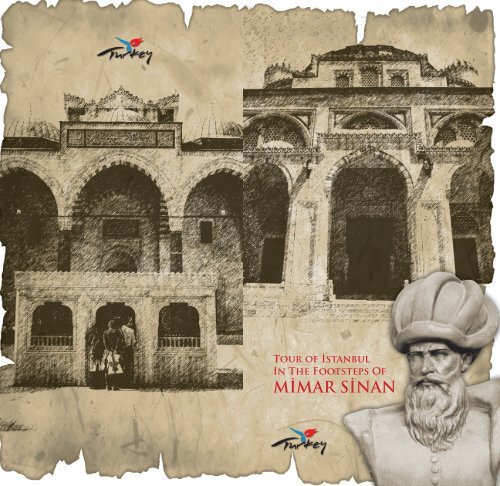
![11. Türk Arkeoloji ve Etnografya Dergisi [2011] - kulturvarliklari.gov.tr](https://img.yumpu.com/50970752/1/182x260/11-turk-arkeoloji-ve-etnografya-dergisi-2011-kulturvarliklarigovtr.jpg?quality=85)
